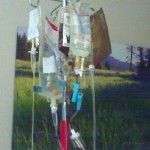.
.
With the amount of needle injections I needed as a Burkitt’s patient like chemotherapy drugs, nutrients, transfusions or just blood tests I needed to have a PORT installed, because your veins would take some serious punishment if you didn’t, that’s my opinion anyways, there may be alternatives that work just as well, but I had a power port that worked great for me.

Power port
l. A port is a surgically implanted device that is used to inject or to withdraw fluids from you, they put me under to install mine and it was just under the skin on left side of my chest just below the collar bone. I have to admit they could hook everything they needed to hook up using various attachments without much of a problem. Below is a scan from the back of my card I was issued after mine was installed. If you want to see what it says just put your mouse pointer over it and click it until you reach its actually size on another webpage. Then click the picture again to see the largest image.


To put things into perspective, I had roughly 350 bags of chemotherapy drugs, transfusions, and nutrients. That is a lot of IV’s. Below are actual images of some of my IV trees during treatment with the Magrath protocol. CODOX-M-IVAC (R)
There are other kinds of Ports, but whichever one they or you go with, I was sure glad I had mine. I found out after treatment that there is a cream they can give you to numb the skin that you apply 30 minutes prior to a needle insertion into the port. EMLA cream is available by prescription from your doctor. If in fact this works it should help with a little of the discomfort, because they generally have to change the needle out on your port at regular maintenance intervals. They also have to flush it to keep it working every four weeks or so, so these are not without their share of needle pricks, but maybe the cream will help. According to our group it is generally recommended that the PORT stays in for up to 12 months after chemotherapy is complete. This however is negotiable with your doctor and I had mine taken out early.
Ommaya port (click the images to see a larger photo)
Ommaya is the last name of the inventor Dr. Ayub Khan Ommaya, MD, ScD (h.c.), FRCS, FACS from Pakistan. People get Ommaya Port’s sometimes instead of the intrathecal chemotherapy injections (lumbar punctures) into the lumbar, which usually number around eight or so for a Burkitt’s patient depending on protocol and situation. They use these punctures for testing you spinal fluid too. For a Burkitt’s patient this means you need to get chemotherapy injected into your spinal fluid ( CSF Cerebrospinal fluid) and this apllies to all Burkitt’s patients whether your CSF tested positive for Burkitt’s or not. Intrathecal Chemotherapy can be tricky and painful so an Ommaya port is in an option that I was never offered, but it is offered at some facilities and once again it depends on the situation or circumstances. I was never offered one but I definitely would have discussed this thoroughly with my ONC (Oncologist) and Surgeon, because this is implanted into your head.
Here is a PDF file that explains Ommaya port pretty well.
http://www.cdha.nshealth.ca/patientinformation/nshealthnet/0265.pdf
The video below is a video that shows a similar device that is used for tumor treatment.
And here is a video of a lumbar puncture.
I am not a doctor and I do not work in the Medical field, what I am is a Burkitt’s patient that has acquired some knowledge from reading countless amounts of literature about Burkitt’s Lymphoma. I am not here to give you medical advice, but am here to voice what I have learned about this horrible cancer from my own experience with it. We encourage you to seek medical advice or to ask questions for the treatment of Burkitt’s from Oncologist’s or the appropriate medical professional after all they saved my life. I learned a lot about Burkitt’s, more than I ever cared to know or ever wanted to know.






thank you for sharing your experience. It helps.
Nobody really knows the exact cause of Sporadic Burkitt’s lymphoma. I also have gained a little to much weight and suspect steroids had something to do with that. All I an suggest is as much exercise that is tolerable.
I agreed with most of the above writings. How does your body develop or contract this cancer also after treatment Ihave gained a lot of weight that I can not lose. Any suggestions?